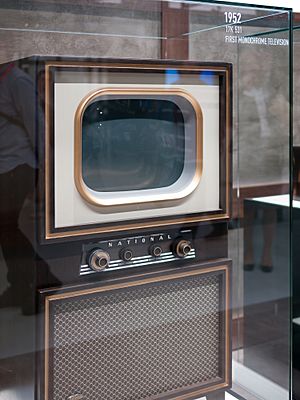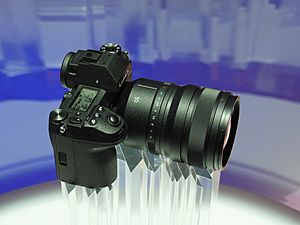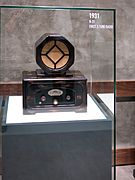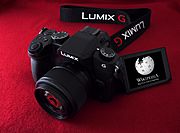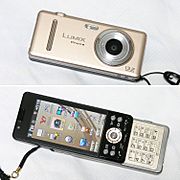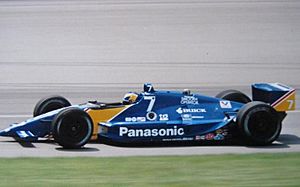Panasonic facts for kids
Corporate logo since 2008
|
|
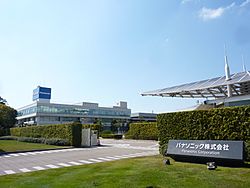
Headquarters in Osaka, Japan
|
|
|
Native name
|
パナソニック ホールディングス株式会社
|
|---|---|
|
Romanized name
|
Panasonikku Hōrudingusu kabushiki gaisha |
|
Formerly
|
|
| Public | |
| Industry | Conglomerate |
| Founded | March 7, 1918 Osaka, Japan |
| Founder | Kōnosuke Matsushita |
| Headquarters | Kadoma, Osaka, Japan 34°44′38″N 135°34′12″E / 34.7438°N 135.5701°E |
|
Area served
|
Worldwide |
|
Key people
|
|
| Products |
|
| Revenue | |
|
Operating income
|
|
| Total assets | |
| Total equity | |
|
Number of employees
|
233,391 (2023) |
| Divisions | Panasonic Corporation of North America (US) |
| Subsidiaries |
List
Panasonic Corporation
Panasonic Automotive Systems Panasonic Entertainment & Communication Panasonic Housing Solutions Panasonic Connect Panasonic Industry Panasonic Energy Panasonic Operational Excellence Anchor Electricals Panasonic Ecology Systems Panasonic Electric Works Panasonic Avionics Corporation Sanyo Electric Co., Ltd. Blue Yonder |
Panasonic Holdings Corporation is a Japanese multinational electronics company, headquartered in Kadoma, Osaka. It was founded in 1918.
In addition to consumer electronics, of which it was the world's largest maker in the late 20th century, Panasonic offers a wide range of products and services, including rechargeable batteries, automotive and avionic systems, industrial systems, as well as home renovation and construction.
Contents
History
Panasonic, then Matsushita Electric, was founded in 1918 by Kōnosuke Matsushita as a vendor of duplex lamp sockets. In the 1920s, Matsushita began regularly launching products. In 1927, he produced a line of bicycle lamps that were the first to be marketed with the National brand name. During World War II, the company operated factories in Japan and other parts of Asia which produced electrical components and appliances such as light fixtures, motors, electric irons, wireless equipment and its first vacuum tubes.
After the war, the Matsushita group, largely having been split into MEI and MEW by the dissolution imposed by the occupation force, imperfectly regrouped as a Keiretsu and began to supply the post-war boom in Japan with radios and appliances, as well as bicycles. Matsushita's brother-in-law, Toshio Iue, founded Sanyo as a subcontractor for components after World War II. Sanyo grew to become a competitor to Matsushita, but was later acquired by Panasonic in December 2009.
In 1961, Matsushita traveled to the United States and met American dealers. The company began producing television sets for the U.S. market under the Panasonic brand name, and expanded the use of the brand to Europe in 1979.
Its plant in 1963 produced eight TV sets per minute, accounting for 21.8% of Japan's production of cathode ray tube television sets at the time, the largest share out of any company.
The company used the National brand outside North America from the 1950s to the 1970s (the trademark could not be used in the United States because it was already in use). The inability to use the National brand name led to the creation of the Panasonic brand in the United States. Over the next several decades, Matsushita released additional products, including black and white TVs (1952), electrical blenders, fridges (1953), rice cookers (1959), color TVs, and microwave ovens (1966).
In 1968, Matsushita began to make rotary compressors for air conditioners, and, in 1971, it began to make absorption chillers, also for air-conditioning applications.
In 1983, Matsushita launched the Panasonic Senior Partner, the first fully IBM PC compatible Japanese-made computer A year later, Panasonic released the Executive Partner, the first affordable portable computer with a plasma display. Around this time the company also introduced inverter air conditioners.
In 1984, Matsushita established the Panasoft software label, which published software for MSX computers from 1984 to 1989. The company also manufactured MSX computers of their own, such as Panasonic FS-A1.
In 1998, Matsushita sold Anam National to Anam Electronics.
In November 2015, Panasonic announced that it set up a new plant in Suzhou, China, through its subsidiary, Panasonic Ecology Systems Co., Ltd, to produce a new type of catalyst-coated diesel particulate filter (DPF) that decomposes matter contained in diesel engine exhaust gas.
In November 2015, Panasonic starts to retail locally harvested produce from its indoor agriculture facility salads via Veggie Life branding in Singapore, from the first licensed indoor vegetable farm in the country using Panasonic's own technology.
In February 2016, Panasonic and the City of Denver formed a formal partnership to make Denver the "smartest" city in the US. Joseph M. Taylor, chairman and CEO of Panasonic Corp. of America, laid out the plans for the partnership in four key areas: smart housing and small offices, energy and utilities, transportation and city services and smart buildings.
In 2016, Panasonic debuted a transparent TV.
On September 25, 2018, Panasonic became one of the founding members of the L-Mount Alliance, and announced two full-frame mirrorless cameras and a range of L-Mount lenses to be launched in 2019. The 47-megapixel Panasonic Lumix S1R and the 24-megapixel Panasonic Lumix S1 will be the first full-frame mirrorless cameras produced by Panasonic and will offer the Lumix Pro support service for professional photographers. These cameras will also be equipped with Dual Image Stabilization technology to help photographers when shooting in low-light.
In 2019, Panasonic sold its semiconductors and security systems (security camera) businesses. The company also decided to completely exit from the liquid-crystal display panel business by 2021, marking the end of its display production, to focus its resources on the automotive and industrial businesses.
In January 2021, the company announced that it would end its solar panel production.
In June 2021, it was reported that Panasonic sold its entire stake in Tesla for $US3.6 billion.
Products
Panasonic has offered a wide range of products and services, including air conditioners, refrigerators, washing machines, compressors, lighting, televisions, personal computers(Matsushita JR series, Let's Note), mobile phones (as a subsidiary of TCL Electronics), audio equipment, cameras, broadcasting equipment, projectors, automotive electronics, aircraft in-flight entertainment systems, semiconductors, lithium batteries, electrical components, optical devices, bicycles, electronic materials and photovoltaic modules. Ventilation appliances such as electric fans are manufactured under KDK and rebranded as Panasonic.
Sponsorships
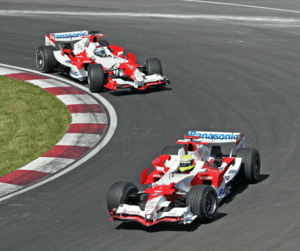
Panasonic was a primary sponsor of Toyota's Formula One program, Panasonic Toyota Racing. Hiro Matsushita, grandson of the company founder, is a former race car driver who ran a company overseeing sponsorship arrangements for the company.
Panasonic was also a sponsor in NASCAR's Busch Series in 2005, sponsoring the No. 67 Smith Brothers Racing Dodge for Ken Schrader, Bryan Reffner, C.W. Smith, and Johnny Benson Jr. In 2007, Panasonic became a technology partner with Hendrick Motorsports and served as a primary sponsor of the team's No. 24 car with Jeff Gordon for two races in 2014 and throughout 2015.
Panasonic has been a top level sponsor of the Olympic Games since the Seoul Olympics in 1988.
Slogans
- "Just slightly ahead of our time" (1970s–1990s)
- "Even more than you expected [out of the blue]" (1970s–1996, Australia)
- "What's on Panasonic" (1990–1996)
- "The quest for zero defect" (1990s–2003, South Africa)
- "Panasonic, The One That I Want" (1996–2003, USA)
- "What's New by Panasonic" (1996–2003)
- "Ideas for Life" (2003–2013, Global)
- "A Better Life, A Better World" (2013–2023)
- "Wonders!" (2014–2017, Japan)
- "Let's Live Life Better" (2017–2018, Indonesia)
- "Live Your Best" (2022–present, Global)
- "Create Today. Enrich Tomorrow." (2022–present)
- "Make New" (2023–present, Japan)
See also
 In Spanish: Panasonic para niños
In Spanish: Panasonic para niños


